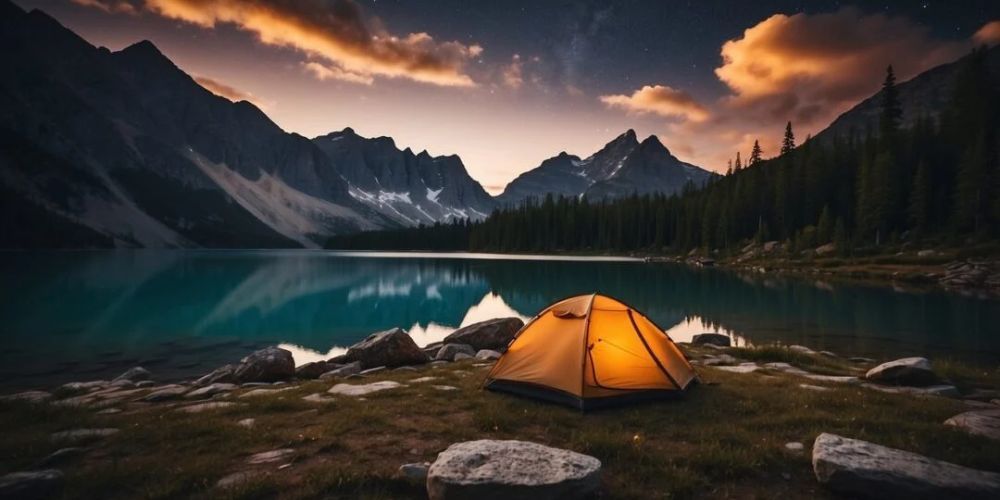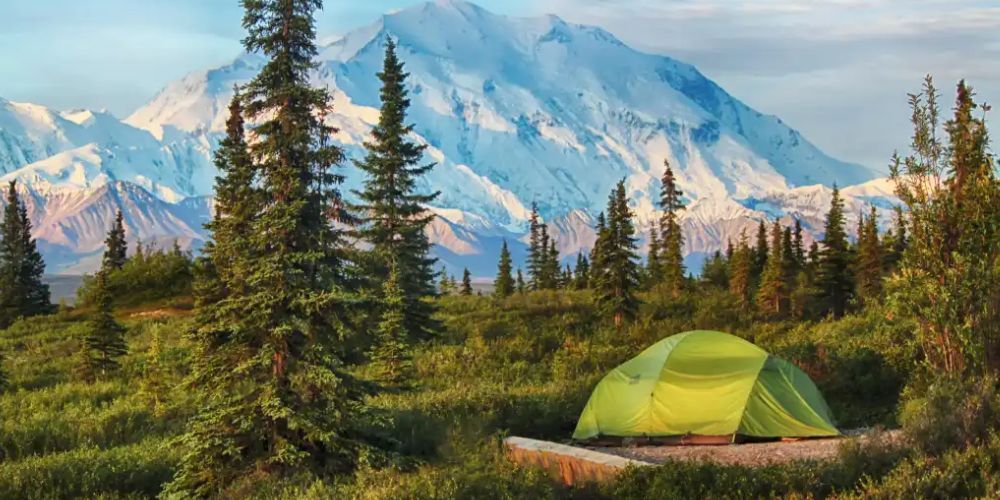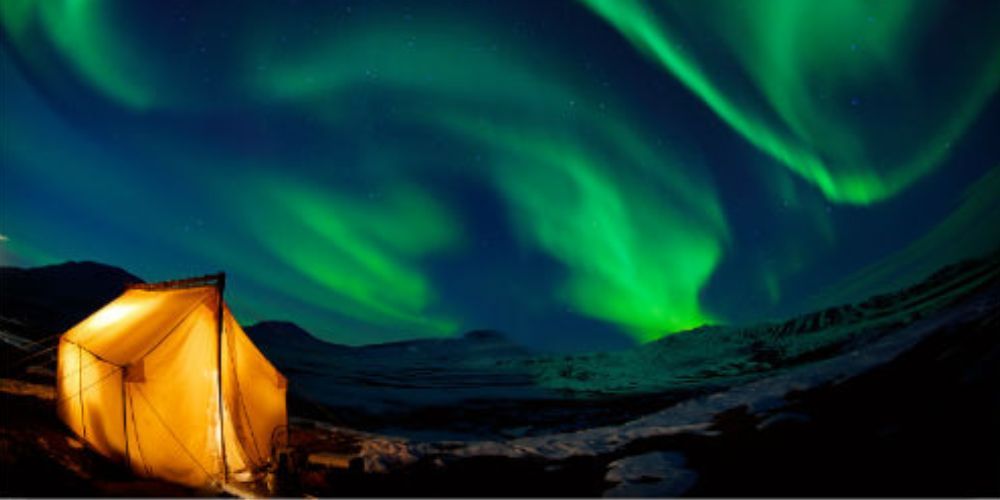Camping in Alaska: The Ultimate Guide to Locations and Tips
Alaska's vast wilderness offers some of the most spectacular camping experiences in the world. From towering mountain ranges and pristine glaciers to lush forests and rugged coastlines, the Last Frontier provides unparalleled opportunities to connect with nature in its most raw and magnificent form.

Hidden Gem Campgrounds in Alaska
While Denali and Kenai Fjords National Parks attract most visitors, Alaska's landscape is dotted with lesser-known camping treasures that locals cherish.
Eklutna Lake Campground sits just 45 minutes from Anchorage but feels worlds away. Nestled between the Chugach Mountains and a crystal-clear glacial lake, this campground offers incredible scenery without the crowds of more famous destinations. The 15-mile lakeside trail provides excellent hiking and mountain biking opportunities.
Nancy Lake State Recreation Area near Willow offers a peaceful paddler's paradise with a canoe trail system connecting dozens of lakes. The quiet campground features wooded sites and access to excellent fishing, making it a perfect retreat from more trafficked areas.
Eagle Trail State Recreation Site near Tok provides a riverside camping experience with stunning mountain views. This small campground serves as an excellent base for exploring the eastern interior and offers a chance to see moose and eagles along the Tok River.
Fielding Lake State Recreation Area along the Denali Highway features alpine camping at 3,000 feet elevation. Despite its incredible scenic value with views of the Alaska Range, it remains relatively unknown to tourists, offering excellent fishing and wildlife viewing without crowds.
Tangle Lakes Campground also on the Denali Highway offers archaeology enthusiasts access to ancient hunting grounds dating back 10,000 years. The surrounding tundra bursts with berries in late summer, and the aurora viewing here is spectacular during the shoulder seasons.
Seasonal Camping Highlights
Summer (June-August): Alaska's peak camping season features long daylight hours—up to 24 hours in northern regions—allowing for extended outdoor activities. Temperatures range from 60-80°F in the interior and 50-65°F along the coast. This is prime time for fishing, hiking, and wildlife viewing. However, summer also brings mosquitoes and crowds. Mid-June through mid-July showcases spectacular wildflower blooms, while late July brings berry picking opportunities. Reservations are highly recommended for this period.
Fall(September-early October): Perhaps Alaska's most magical camping season, featuring vibrant foliage, especially in Denali and the interior regions. Temperatures cool to 30-50°F, crowds thin dramatically, and mosquitoes disappear. Fall brings excellent opportunities for northern lights viewing as darkness returns. Wildlife becomes more active with the cooler temperatures, though weather can change rapidly, requiring proper preparation.
Winter(October-April): Winter camping in Alaska is an adventure for the well-prepared. Many campgrounds close, but those that remain open offer solitude and extraordinary experiences. Temperatures range from 30°F to well below zero. Winter campers can experience pristine snow-covered landscapes, incredible aurora displays, and the profound silence of Alaska's wilderness. Specialized winter equipment and experience are essential.
Spring(May-early June): A short but rewarding season as Alaska transitions from winter. Wildlife becomes highly active with the return of migratory birds and animals emerging from hibernation. Melting snow creates dramatic waterfalls, though muddy conditions (locally called "breakup") can make some areas inaccessible. Early spring camping often means having entire campgrounds to yourself, though nights remain cold and some facilities may still be closed.
Local Wildlife to Watch For
Alaska's diverse ecosystems support an abundance of wildlife that enhances—and sometimes complicates—the camping experience:
Large Mammals: The "Big Five" include grizzly and black bears, moose, caribou, and Dall sheep. While seeing these animals is a highlight for many campers, proper safety precautions are essential, particularly with bears and moose, which can be aggressive. Always maintain a safe distance (minimum 300 feet for bears, 50 feet for moose) and carry bear spray in accessible locations.
Marine Mammals: Coastal campers may spot sea otters, harbor seals, sea lions, and even whales from shore. The Kenai Peninsula and Southeast Alaska offer excellent opportunities for marine wildlife viewing from coastal campgrounds.
Birds: Alaska hosts remarkable bird diversity, from massive bald eagles to tiny rufous hummingbirds. Watch for ptarmigan in alpine areas, loons on lakes, and thousands of migratory birds in wetlands. The Copper River Delta and Kenai River flats are particularly rich birding locations near campgrounds.
Fish: Alaska's waters teem with salmon (five species), rainbow trout, Arctic grayling, northern pike, and many other species. Watching salmon runs—particularly sockeye and silver salmon—from campgrounds along rivers provides an unforgettable natural spectacle.
Safety Considerations: Proper food storage is critical in all Alaskan campgrounds. Use bear-resistant containers, never store food or scented items in tents, and cook at least 100 feet from your sleeping area. Learn how to identify bear tracks and scat to increase awareness of your surroundings.
Best Water-Based Campsites for Swimming, Paddling, and Fishing
Alaska's abundance of lakes, rivers, and coastline creates perfect opportunities for water-loving campers:
Byers Lake Campground in Denali State Park offers excellent lake access with stunning views of Denali on clear days. The campground features boat rentals and access to a 5-mile loop trail around the lake. Anglers can target Arctic grayling and lake trout, while paddlers enjoy the no-motorized-boats policy that ensures peaceful exploration.
Quartz Creek Campground on Kenai Lake provides access to one of the most beautiful turquoise glacial lakes in Alaska. Though the water remains chilly year-round (swimming is for the brave), the fishing for rainbow trout and Dolly Varden is excellent. The campground sits at the junction of Quartz Creek and Kenai Lake, providing diverse fishing opportunities.
Red Shirt Lake Cabin Sites in Nancy Lake State Recreation Area offer a unique experience—accessible only by canoe or kayak (a 3-mile paddle), these remote cabins and tent platforms provide a true wilderness experience with excellent fishing for northern pike and peaceful paddling through interconnected lakes.
Copper River Campground near Chitina gives anglers access to the famous Copper River dipnet fishery (Alaska residents only) and rod-and-reel opportunities for salmon and trout. The powerful river isn't suitable for swimming but provides spectacular scenery and fishing access.
Kasitsna Bay near Homer requires a water taxi but rewards campers with remote beaches, excellent tidepooling, kayaking opportunities among sea otters and seals, and remarkable access to ocean fishing.

Camping with a Cultural Twist: Historic or Unique Local Attractions
Enhance your Alaska camping trip by exploring the rich history and Indigenous cultures near these campgrounds:
Tangle Lakes Campground sits amidst one of Alaska's richest archaeological districts, where evidence of human habitation dates back 10,000 years. The nearby Bureau of Land Management visitor center offers interpretive displays about the ancient caribou hunters who used this important migration corridor.
Ninilchik River Campground on the Kenai Peninsula places campers near the historic Russian Orthodox village of Ninilchik. The picturesque church overlooking Cook Inlet dates to 1846 and reflects Alaska's Russian heritage. The nearby Native village shares Alutiiq cultural history.
Eagle Trail State Recreation Site positions campers near the historic gold rush town of Eagle. This remarkably preserved community served as a crucial Yukon River port and housed Alaska's first federal courthouse. Guided walking tours showcase buildings dating to the early 1900s.
K'esugi Ken Campground in Denali State Park features a modern interpretation center with exhibits on Athabascan cultural connections to the land. Traditional use of plants, animals, and landscape is explained through Indigenous perspectives, adding depth to the camping experience.
Fort Abercrombie State Historic Park on Kodiak Island combines camping with exploring a WWII coastal defense installation. Bunkers, gun emplacements, and a military history museum provide context for Alaska's strategic importance during the war and the little-known Japanese bombing and occupation of the Aleutian Islands.

Alaska Campfire Cooking: Regional Dishes and Tips
Elevate your camping meals with these Alaska-inspired outdoor cooking ideas:
Salmon Foil Packets: Fresh-caught salmon (or brought from local markets) cooked in foil with wild berries, lemon, and local spruce tips creates a distinctly Alaskan flavor. The technique works well over campfires or camp stoves.
Sourdough Pancakes: Alaska's gold rush history brought sourdough traditions that continue today. Bring a starter (available at many Alaska bakeries) and make breakfast pancakes topped with wild blueberries, cranberries, or salmonberries gathered near your campsite (where permitted).
Dutch Oven Reindeer Stew: Reindeer (domesticated caribou) sausage or meat is widely available in Alaska markets and makes a hearty, distinctive stew with root vegetables that can simmer over a campfire in a Dutch oven.
Spruce Tip Tea: In early summer, the bright green new growth on spruce trees can be harvested to make a vitamin C-rich tea with a surprisingly citrusy flavor—a traditional remedy used by both Alaska Natives and settlers.
Pilot Bread Creations: This sturdy cracker (similar to hardtack) is a staple in rural Alaska. Create "Alaska sushi" by topping pilot bread with seal oil or butter and smoked salmon, or make a dessert version with wild berry jam.
Foraging Tips: Alaska offers abundant berries in summer and fall—blueberries, cranberries, raspberries, and unique varieties like salmonberries and cloudberries. Learn proper identification and incorporate these into pancakes, muffins, or eat fresh. Always forage ethically, taking only what you need and leaving plenty for wildlife.
Local Events Near Campgrounds
Time your camping trip to coincide with these unique Alaska events:
Summer
- Girdwood Forest Fair (July, Girdwood) – Camp at nearby Bird Creek and enjoy this eclectic celebration of music, crafts, and food in a mountain setting.
- Copper River Wild Salmon Festival (June, Cordova) – Camp at Shelter Bay and celebrate the season's first salmon run with fishing competitions and culinary events.
Fall
- Talkeetna Riverside Music Festival (August, Talkeetna) – Camp at Montana Creek and enjoy this authentic Alaska music experience in a historic gold mining community.
- Alaska State Fair (August-September, Palmer) – Camp at Kepler-Bradley Lakes and visit the fair featuring Alaska's famous giant vegetables and cultural displays.
Winter
- Fur Rendezvous (February, Anchorage) – Winter camp at Eagle River and experience this historic festival celebrating Alaska's fur trading heritage with unique events like the Running of the Reindeer.
- Yukon Quest or Iditarod (February-March, various locations) – Winter camping along these famous dog sled race routes provides a chance to witness an iconic Alaska tradition.
Spring
- Kachemak Bay Shorebird Festival (May, Homer) – Camp at Homer Spit and join bird enthusiasts celebrating the return of millions of migratory birds.
- Arctic Man (April, Summit Lake) – Winter camp in the Hoodoo Mountains to experience this uniquely Alaskan extreme skiing and snowmachine event.
Camping in Alaska offers experiences not found anywhere else in America. The state's vastness, diversity, and wildness create opportunities to truly disconnect from civilization and connect with nature in profound ways. Whether you're relaxing beside a glacial lake under the midnight sun or watching the northern lights dance above your winter campsite, Alaska's camping experiences leave lasting impressions that call visitors back year after year. Proper preparation, respect for the environment, and a sense of adventure are key to making the most of your Alaska camping experience.
Author: William Flaiz
Check out these other activities in Alaska
Check out activities in these nearby states: Washington , Oregon , California , Hawaii
